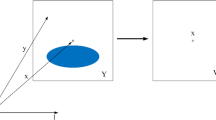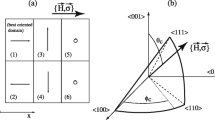Abstract
Ferromagnetic materials are characterized by a heterogeneous micro-structure that can be altered by external magnetic and mechanical stimuli. The understanding and the description of the micro-structure evolution is of particular importance for the design and the analysis of smart materials with magneto-mechanical coupling. The macroscopic response of the material results from complex magneto-mechanical interactions occurring on smaller length scales, which are driven by magnetization reorientation and associated magnetic domain wall motions. The aim of this work is to directly base the description of the macroscopic magneto-mechanical material behavior on the micro-magnetic domain evolution. This will be realized by the incorporation of a ferromagnetic phase-field formulation into a macroscopic Boltzmann continuum by the use of computational homogenization. The transition conditions between the two scales are obtained via rigorous exploitation of rate-type and incremental variational principles, which incorporate an extended version of the classical Hill–Mandel macro-homogeneity condition covering the phase field on the micro-scale. An efficient two-scale computational scenario is developed based on an operator splitting scheme that includes a predictor for the magnetization on the micro-scale. Two- and three-dimensional numerical simulations demonstrate the performance of the method. They investigate micro-magnetic domain evolution driven by macroscopic fields as well as the associated overall hysteretic response of ferromagnetic solids.















Similar content being viewed by others
Notes
There exist materials that show even higher deformations under applied magnetic field, given by ferromagnetic shape memory alloys (these show strains in the order of a few percent). The governing effects taking place in shape memory alloys are however different from those in pure ferromagnets and will not be considered in the present contribution. For more information see, for example, Kiefer et al. [30].
The magnetostrictive strain for a cubic response in (57) can be explicitly written as,
$$\begin{aligned} {\varvec{\varepsilon }}_0=\frac{3}{2} \begin{pmatrix} E_{100}(m_1^2-1/3) &{} E_{111}m_1m_2 &{} E_{111}m_1m_3 \\ E_{111}m_2m_1 &{} E_{100}(m_2^2-1/3) &{} E_{111}m_2m_3 \\ E_{111}m_3m_1 &{} E_{111}m_3m_2 &{} E_{100}(m_3^2-1/3) \end{pmatrix} _{CF} \end{aligned}$$The material modulus \({\varvec{\mathcal {K}}}\) can be filled with the entries \({\mathcal {K}}_{1111}{=} E_{100}, {\mathcal {K}}_{2222}{=} E_{100}, {\mathcal {K}}_{3333}{=} E_{100}, {\mathcal {K}}_{1212}{=} {\mathcal {K}}_{1221}{=}E_{111}/2, {\mathcal {K}}_{2112}{=} {\mathcal {K}}_{2121}{=}E_{111}/2, {\mathcal {K}}_{1313}= {\mathcal {K}}_{1331}=E_{111}/2, {\mathcal {K}}_{3113}= {\mathcal {K}}_{3131}=E_{111}/2, {\mathcal {K}}_{2323}= {\mathcal {K}}_{2332}=E_{111}/2, {\mathcal {K}}_{3223}= {\mathcal {K}}_{3232}=E_{111}/2\). The fourth order cubic mechanical modulus \({\mathbb {C}}^{cub}\) in (58) is given as
$$\begin{aligned} {\mathbb {C}}^{cub}= \begin{pmatrix} {\mathbb {C}}_{11} &{} {\mathbb {C}}_{12} &{} {\mathbb {C}}_{12} &{} &{} &{} \\ {\mathbb {C}}_{12} &{} {\mathbb {C}}_{11} &{} {\mathbb {C}}_{12} &{} &{} &{} \\ {\mathbb {C}}_{12} &{} {\mathbb {C}}_{12} &{} {\mathbb {C}}_{11} &{} &{} &{}\\ &{} &{} &{}{\mathbb {C}}_{44} &{} &{}\\ &{} &{} &{} &{}{\mathbb {C}}_{44} &{} \\ &{} &{} &{} &{} &{}{\mathbb {C}}_{44} \end{pmatrix}. \end{aligned}$$
References
Abbundi R, Clark A (1977) Anomalous thermal expansion and magnetostriction of single crystal \({\rm Tb}_{27}{\rm Dy}_{73}{\rm Fe}_2\). Magn IEEE Trans 13(5):1519–1520. doi:10.1109/TMAG.1977.1059598
Berger H, Kari S, Gabbert U, Rodriguez-Ramos R, Guinovart R, Otero J, Bravo-Castillero J (2005) An analytical and numerical approach for calculating effective material coefficients of piezoelectric fiber composites. Int J Solids Struct 42(21–22):5692–5714. doi:10.1016/j.ijsolstr.2005.03.016
Bertram HN (1994) Theory of magnetic recording. Cambridge University Press, Cambridge
Brassart L, Stainier L, Doghri I, Delannay L (2011) A variational formulation for the incremental homogenization of elasto-plastic composites. J Mech Phys Solids 59(12):2455–2475. doi:10.1016/j.jmps.2011.09.004
Brown WF Jr (1966) Magnetoelastic interactions, tracts in natural philosophy, vol 9. Springer-Verlag, New York
Brun M, Lopez-Pamies O, Ponte Castañeda P (2007) Homogenization estimates for fiber-reinforced elastomers with periodic microstructures. Int J Solids Struct 44:5953–5979
Claeyssen F, Lhermet N, Letty RL, Bouchilloux P (1997) Actuators, transducers and motors based on giant magnetostrictive materials. J Alloys Compd 258(1–2):61–73. doi:10.1016/S0925-8388(97)00070-4
Clark AE, Restorff JB, Wun-Fogle M, Hathaway KB, Lograsso TA, Huang M, Summers E (2007) Magnetostriction of ternary fe-ga-x(x=c, v, cr, mn, co, rh) alloys. J Appl Phys 101(9):09C507. doi:10.1063/1.2670376
Cullity BD (1972) Introduction to magnetic materials. Addison-Wesley, Reading
Daniel L, Hubert O, Billardon R (2004) Homogenisation of magneto-elastic behaviour: from the grain to the macro scale. Comput Appl Math 23:285–308
Daniel L, Hubert O, Buiron N, Billardon R (2008) Reversible magneto-elastic behavior: a multiscale approach. J Mech Phys Solids 56(3):1018–1042
DeSimone A (1993) Energy minimizers for large ferromagnetic bodies. Arch Ration Mech Anal 125:99–143
DeSimone A, James R (2002) A constrained theory of magnetoelasticity. J Mech Phys Solids 50:283–320
DeSimone A, Kohn RV, Müller S, Otto F (2004) Recent analytical developments in micromagnetics. Technical report, Max-Planck-Institut für Mathematik in den Naturwissenschaften, Leipzig
Engdahl G (2000) Handbook of giant magnetostrictive materials. Academic Press, San Diego
Ethiraj G, Sridhar A, Miehe C (2015) Variational modeling and homogenization in dissipative magneto-mechanics. GAMM-Mitt 38(1):75–101. doi:10.1002/gamm.201510004
Gilbert TL (1956) Formulation, foundations, and applications of the phenomenological theory of ferromagnetism. Ph.D. thesis, Illinois Institute of Technology
Gilbert TL (2004) A phenomenological theory of damping in ferromagnetic materials. IEEE Trans Magn 40:3443–3449
Goll D, Kronmüller H (2000) High-performance permanent magnets. Naturwissenschaften 87(10):423–438
Greaves S (2008) Micromagnetic simulations of magnetic recording media. In: High performance computing on vector systems 2007. Springer, Berlin
Hill R (1972) On constitutive macro-variables for heterogeneous solids at finite strain. Proc R Soc Lond (Ser A) 326:131–147
Hirsinger L, Barbier G, Billardon R (2000) Application of the internal variable formalism to the modelling of magneto-elasticity. Mech Electromagn Mater Struct 19:54–67
Hu R, Soh AK, Zheng GP, Ni Y (2006) Micromagnetic modeling studies on the effects of stress on magnetization reversal and dynamic hysteresis. J Magn Magn Mater 301(2):458–468. doi:10.1016/j.jmmm.2005.07.023
Hubert A, Schäfer R (2001) Magnetic domains. Springer-Verlag, New York
James R, Kinderlehrer D (1990) Frustration in ferromagnetic materials. Contin Mech Thermodyn 2:215–239
Javili A, Chatzigeorgiou G, Steinmann P (2013) Computational homogenization in magnetomechanics. Int J Solids Struct 50:4197–4216
Kankanala S, Triantafyllidis N (2004) On finitely strained magnetorheological elatomers. J Mech Phys Solids 52:2869–2908
Keip MA, Steinmann P, Schröder J (2014) Two-scale computational homogenization of electro-elasticity at finite strains. Comput Methods Appl Mech Eng 278:62–79
Keip MA, Schrade D, Thai H, Schröder J, Svendsen B, Müller R, Gross D (2015) Coordinate-invariant phase field modeling of ferroelectrics, part II: application to composites and polycrystals. GAMM-Mitt 38(1):115–131. doi:10.1002/gamm.201510006
Kiefer B, Karaca H, Lagoudas D, Karaman I (2007) Characterization and modeling of the magnetic field-induced strain and work output in magnetic shape memory alloys. J Magn Magn Mater 312(1):164–175. doi:10.1016/j.jmmm.2006.09.035
Kittel C (1949) Physical theory of ferromagnetic domains. Rev Mod Phys 21(4):541–583
Kittel C (1956) Introduction to solid state physics, 2nd edn. Wiley, New York
Kouznetsova V (2002) Computational homogenization for the multi-scale analysis of multi-phase materials. Ph.D. thesis, Institute of Mechanics of Materials, TU Eindhoven
Kouznetsova V, Geers MGD, Brekelmans WAM (2002) Multi-scale constitutive modelling of heterogeneous materials with a gradient-enhanced computational homogenization scheme. Int J Numer Methods Eng 54:1235–1260
Kouznetsova V, Geers M, Brekelmans W (2004) Multi-scale second-order computational homogenization of multi-phase materials: a nested finite element solution strategy. Comput Methods Appl Mech Eng 193:5525–5550
Kružík M, Prohl A (2006) Recent developments in the modeling, analysis, and numerics of ferromagnetism. SIAM Rev 48:439–483
Kuznetsov S, Fish J (2012) Mathematical homogenization theory for electroactive continuum. Int J Numer Methods Eng 91(11):1199–1226. doi:10.1002/nme.4311
Lahellec N, Suquet P (2007) On the effective behavior of nonlinear inelastic composites: I. Incremental variational principles. J Mech Phys Solids 55(9):1932–1963. doi:10.1016/j.jmps.2007.02.003
Landau LD, Lifshitz EM (1935) On the theory of the dispersion of magnetic permeability in ferromagnetic bodies. Physikalische Zeitschrift der Sowjetunion 8:153–169
Landis CM (2008) A continuum thermodynamics formulation for micro-magnetomechanics with applications to ferromagnetic shape memory alloys. J Mech Phys Solids 56:3059–3076
Liang CY, Keller SM, Sepulveda AE, Bur A, Sun WY, Wetzlar K, Carman GP (2014) Modeling of magnetoelastic nanostructures with a fully coupled mechanical-micromagnetic model. Nanotechnology 25(43):435,701
Linnemann K, Klinkel S, Wagner W (2009) A constitutive model for magnetostrictive and piezoelectric materials. Int J Solids Struct 46:1149–1166
Miehe C (2002) Strain-driven homogenization of inelastic microstructures and composites based on an incremental variational formulation. Int J Numer Methods Eng 55:1285–1322
Miehe C (2003) Computational micro-to-macro transitions of discretized micro-structures of heterogeneous materials at finite strains based on the minimization of averaged incremental energy. Comput Methods Appl Mech Eng 192:559–591
Miehe C (2011) A multi-field incremental variational framework for gradinet-type standard dissipative solids. J Mech Phys Solids 59(4):898–923
Miehe C, Dettmar J (2004) A framework for micro-macro transitions in periodic particle aggregates of granular materials. Comput Methods Appl Mech Eng 193:225–256
Miehe C, Ethiraj G (2012) A geometrically consistent incremental variational formulation for phase field models in micromagnetics. Comput Methods Appl Mech Eng 245–246:331–347
Miehe C, Dettmar J, Zäh D (2010) Homogenization and two-scale simulations of granular materials for different microstructural constraints. Int J Numer Methods Eng 83:1206–1236
Miehe C, Kiefer B, Rosato D (2011) An incremental variational formulation of dissipative magnetostriction at the macroscopic continuum level. Int J Solids Struct 48:1846–1866
Miehe C, Rosato D, Kiefer B (2011) Variational principles in dissipative electro-magneto-mechanics: a framework for the macro-modeling of functional materials. Int J Numer Methods Eng 86:1225–1276
Miehe C, Zäh D, Rosato D (2012) Variational-based modeling of micro-electro-elasticity with electric field- and stress-driven domain evolution. Int J Numer Methods Eng 91(2):115–141
Nemat-Nasser S, Hori M (1999) Micromechanics: overall properties of heterogeneous materials. In: North-Holland series in applied mathematics and mechanics, vol. 36, 2nd edn. Elsevier Science Publisher B.V
Olabi A, Grunwald A (2008) Design and application of magnetostrictive materials. Mater Des 29(2):469–483. doi:10.1016/j.matdes.2006.12.016
Özdemir I, Brekelmans WAM, Geers MGD (2008) Computational homogenization for heat conduction in heterogeneous solids. Int J Numer Methods Eng 73(2):185–204
Pisante G (2004) Homogenization of micromagnetics large bodies. ESAIM: control, optimisation and calculus of variations
Ponte Castañeda P, Galipeau E (2011) Homogenization-based constitutive models for magnetorheological elastomers at finite strain. J Mech Phys Solids 59:194–215
Ponte Castañeda P, Siboni M (2012) A finite-strain constitutive theory for electro-active polymer composites via homogenization. Int J Non-Linear Mech 47(2):293–306. doi:10.1016/j.ijnonlinmec.2011.06.012
Ponte Castañeda P, Suquet P (1997) Nonlinear composites. Elsevier, Amsterdam
Sablik MJ, Jiles DC (1993) Coupled magnetoelastic theory of magnetic and magnetostrictive hysteresis. IEEE Trans Magn 29(3):2113–2123
Sandlund L, Fahlander M, Cedell T, Clark AE, Restorff JB, Wun-Fogle M (1994) Magnetostriction, elastic moduli, and coupling factors of composite terfenol-d. J Appl Phys 75(10):5656–5658. doi:10.1063/1.355627
Schrefl T, Fidler J, Kronmüller H (1994) Remenence and coercivity in isotropic nanocrystalline permanent magnets. Phys Rev B 49(9):6100–6110
Schröder J (2009) Derivation of the localization and homogenization conditions for electro-mechanically coupled problems. Comput Mater Sci 46:595–599
Schröder J, Keip MA (2012) Two-scale homogenization of electromechanically coupled boundary value problems. Comput Mech 50(2):229–244
Shu YC, Lin MP, Wu KC (2004) Micromagnetic modeling of magnetostrictive materials under intrinsic stress. Mech Mater 36(10):975–997 Active Materials
Smith RC, Dapino MJ, Seelecke S (2003) Free energy model for hysteresis in magnetostrictive transducers. J Appl Phys 93(1):458–466
Spaldin NA (2003) Magnetic materials: fundamentals and device applications. Cambridge University Press, Cambridge
Suquet P (1987) Elements of homogenization for inelastic solid mechanics. In: Sanchez-Palenzia E, Zaoui A (eds.) Lecture Notes in Physics: Homogenization Techniques for Composite Materials, vol. 272 edn. Springer-Verlag, pp 193–278
Temizer I, Wriggers P (2011) Homogenization in finite thermoelasticity. J Mech Phys Solids 59(2):344–372. doi:10.1016/j.jmps.2010.10.004
Yi M, Xu BX (2014) A constraint-free phase field model for ferromagnetic domain evolution. Proc R Soc A 470(2171):20140,517. doi:10.1098/rspa.2014.0517
Zäh D, Miehe C (2013) Computational homogenization in dissipative electro-mechanics of functional materials. Comput Methods Appl Mech Eng 267:487–510
Zhang JX, Chen LQ (2005) Phase-field microelasticity theory and micromagnetic simulations of domain structures in giant magnetostrictive materials. Acta Mater 53:2845–2855
Zhang JX, Chen LQ (2005) Phase-field model for ferromagnetic shape-memory alloys. Philos Mag Lett 85:533–541
Acknowledgments
The authors thank the German Research Foundation (DFG) for financial support of the projects under the grants Mi 295/71-1 and KE 1849/2-2 within the research unit FOR 1509. M.-A.K. thanks the “Ministerium für Wissenschaft, Forschung und Kunst des Landes Baden-Württemberg” as well as the DFG in the framework of the Cluster of Excellence in “Simulation Technology” (EXC 310/2) at the University of Stuttgart.
Author information
Authors and Affiliations
Corresponding author
Rights and permissions
About this article
Cite this article
Sridhar, A., Keip, MA. & Miehe, C. Homogenization in micro-magneto-mechanics. Comput Mech 58, 151–169 (2016). https://doi.org/10.1007/s00466-016-1286-y
Received:
Accepted:
Published:
Issue Date:
DOI: https://doi.org/10.1007/s00466-016-1286-y




